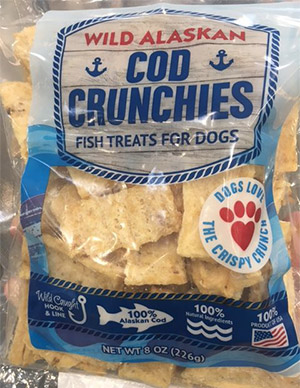|
Fish Factor National Roll Out of Alaskan Cod CrunchiesBy LAINE WELCH
October 02, 2016
“It’s pure, 100 percent human grade trimmings coming right off the cod fillets,” said Keith Singleton, president of the company’s value added division. Alaskan Leader’s four freezer/longline vessels are owned in partnership with the Bristol Bay Economic Development Corporation (BBEDC) and fish primarily for cod in the Bering Sea. Besides the frozen at sea fillets, Alaskan Leader also has developed markets for (and thereby monetized) all of the cod heads, livers and skins. The Crunchies, which have been under development for about a year, are dried and shaped into crispy, domino sized wafers. Taste tests with numerous dogs proved the product was a winner. “Boy, they get going on that crunch and it’s like that potato chip commercial that says ‘you can’t just eat one.’ They keep coming back for more,” Singleton said. Dillingham dogs agreed, according to Robin Samuelson, president of Ocean Beauty Seafoods and chairman of BBEDC. “When I came home to Dillingham I had two sacks with me and there was a 12-week old black lab. I opened them up and said let’s put it to the test, and that little dog loved the cod treats,” Samuelson said with a laugh. “What’s most exciting is Costco chose Alaska to debut the product. We feel really blessed about that,” Singleton added. The buzz surrounding the new Cod Crunchies is exciting, echoed Samuelson, but to him, the bigger story is the full use of the fish that comes over the rails. “It’s a new product that we think will do good throughout the U.S.,” he said. “And it’s the full utilization of the species and we’re just tickled pink.” October is National Seafood Month – a distinction proclaimed by Congress more than 30 years ago to recognize one of our nation’s oldest industries. Government figures show that nationwide, the seafood industry contributes $60 billion to the U.S. economy each year. Alaska deserves special merit during Seafood Month, as it produces about 65 percent of our nation’s wild-caught seafood, more than all the other states combined. The seafood industry also is Alaska’s number one private employer – it puts more people to work than oil and gas, mining, timber and tourism industries combined. Americans eat about 16 pounds of seafood per person each year. which pales in comparison to other parts of the world. The Japanese, for example, eat 146 pounds of seafood per person annually. Figures from the United Nation’s Food and Agriculture Organization show that people in Greenland eat 186 pounds per capita, and in Iceland more than 200 pounds of seafood are eaten annually. The country with the lowest seafood consumption is Afghanistan at zero. And where in the world is the most seafood eaten? The South Pacific island of Tokelau where each person eats more than 440 pounds of seafood every year. To whet more American appetites for seafood, Chicken of the Sea has claimed October 8 as National Salmon Day. The company uses Alaska pink salmon in its pouched and canned products and the promotion is a way to highlight the iconic fish. “We wanted to get behind an effort to create a Salmon Day for anyone and everyone who provides salmon, and/or serves salmon. Wild or packaged, anyway that we can get people to eat more salmon, that is our goal,” said company spokesman Bob Ochsner. “Tuna has a day, lobster, crab, even clams have a day,” he continued. “We believed strongly that it was appropriate for the second most popular seafood in the United States to have its own day.” To coincide with the second annual event, Chicken of the Sea has rolled out its list of the Top 10 U.S. Salmon Cities, where residents eat more fresh and shelf-stable salmon per person than counterparts in other cities. The top 10, in no particular order, are Anchorage, Seattle Chicago, Cincinnati and Columbus, Ohio; Baltimore, Nashville, New York City, San Diego and Washington, D.C. Salmon lovers can use the hashtag #NationalSalmonDay on their social media platforms on October 8 to be entered for a week-long Alaska cruise and other prizes. Fall fish meetings Fish meetings over the next few months give industry stakeholders a chance to participate in policy-making that directly affects their livelihoods. The North Pacific Fishery Management Council meets October 5 – 11 at the Anchorage Hilton. The agenda includes a first look at next year’s catch quotas for pollock, cod, flounders and other groundfish in federally managed waters (three to 200 miles out), which account for over 80 percent of Alaska’s harvest poundage. The International Pacific Halibut Commission is calling for 2017 regulatory and catch limit proposals, due by October 31. The industry will get a first glimpse at next year’s halibut catch recommendations at the IPHC interim meeting set for November 29-30 in Seattle. The halibut commission’s annual meeting will take place January 23-27 in Victoria, British Columbia. The eight month halibut fishery opens in March. All of the fish meetings are available online as they happen.
Laine Welch ©2016 Laine can be reached
at msfish[AT]alaska.com
Representations of fact and opinions in comments posted below are solely those of the individual posters and do not represent the opinions of Sitnews.
SitNews ©2016 Stories In The News Ketchikan, Alaska
|
|||

